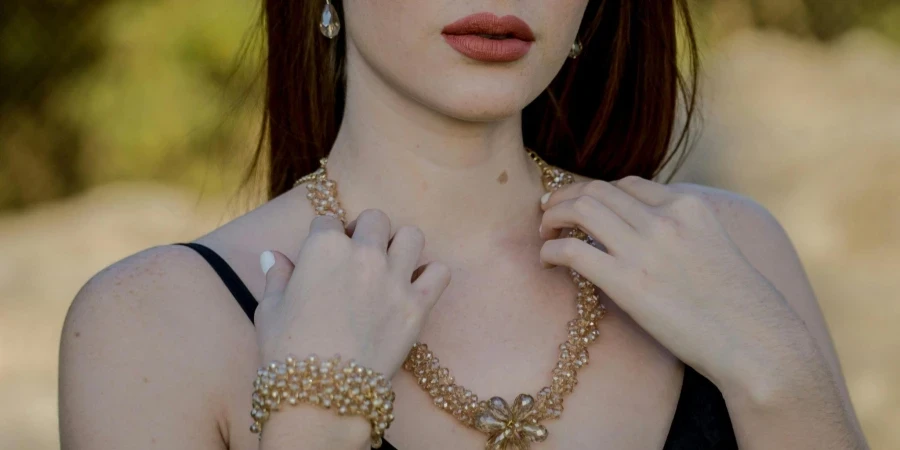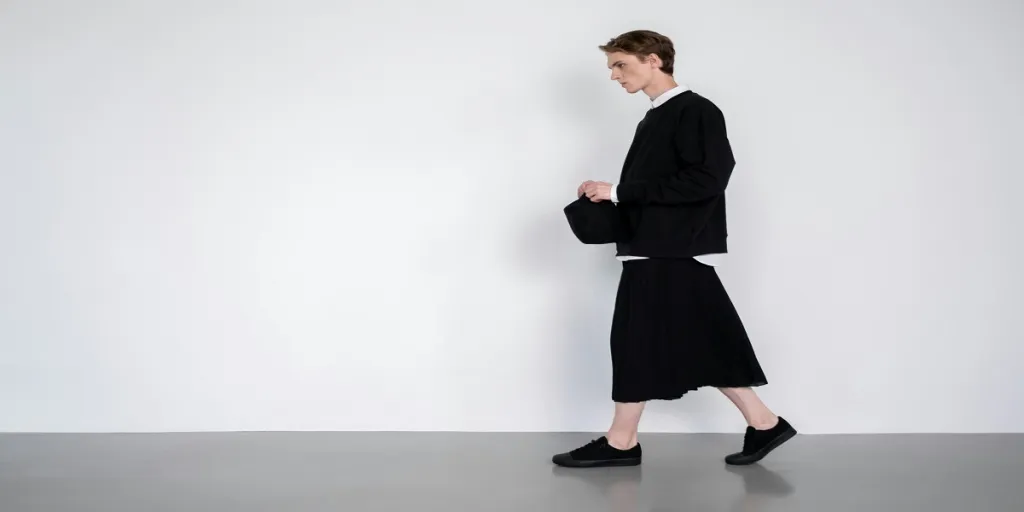The Autumn/Winter 2025/26 collections have fundamentally reconfigured accessory hierarchies across global fashion capitals. Catwalk data reveals a decisive migration from ear-level adornment toward neck-focused statements, signalling profound shifts in consumer behaviour and design priorities. This transformation extends beyond seasonal aesthetics into cultural anthropology, reflecting society’s negotiation between digital fatigue and physical-world re-engagement through intentional materiality.
Industry leaders must now decode these changes through strategic frameworks that prioritise ergonomic innovation and historical reinterpretation. The convergence of post-pandemic visibility needs, sustainability imperatives, and generational nostalgia creates unprecedented opportunities for brands synthesising conceptual boldness with commercial pragmatism.
Table of Contents
Neckwear Ascendancy and Cultural Drivers
Brooches: Subversion Through Surrealism
Material Innovation and Ergonomic Maximalism
Reinterpreted Nostalgia: The 1980s Reframed
Category Synergies and Modular Consumption
Wristwear: Technical Innovation in Secondary Markets
Strategic Implications and Forward Pathways
Conclusion: The New Adornment Paradigm
Neckwear Ascendancy and Cultural Drivers

Earrings retained category dominance at 48.7% but contracted by 3.9 percentage points year-over-year, marking the most significant decline since 2018. Conversely, necklaces surged 12 percentage points to capture 34.6% of runway representations, establishing collars and chokers as winter’s definitive silhouettes. This redistribution coincides with hybrid work normalization, where reduced video-conference exposure diminishes earwear’s strategic importance while elevating décolletage framing for physical interactions. Fendi’s architectural interpretation exemplifies this shift through interlocking steel triangles precisely engineered at 2.3cm per unit with brushed light-diffusing surfaces.
Market validation materialises through multiple vectors, confirming the trend’s commercial viability. Google Trends data indicates a 78% Q1 2025 surge in “statement collar necklace” searches across Anglo-American markets, while Statista projects 14.2% annual growth for vintage neckwear through 2027. Simultaneously, Loewe’s leather choker embedded with 37 raw Baltic amber nodules in a 220g hollow-core construction represents the material experimentation driving category innovation. Instagram’s #CollarCore movement further demonstrates consumer adoption, amassing 890,000 user-generated posts within six months.
Brooches: Subversion Through Surrealism
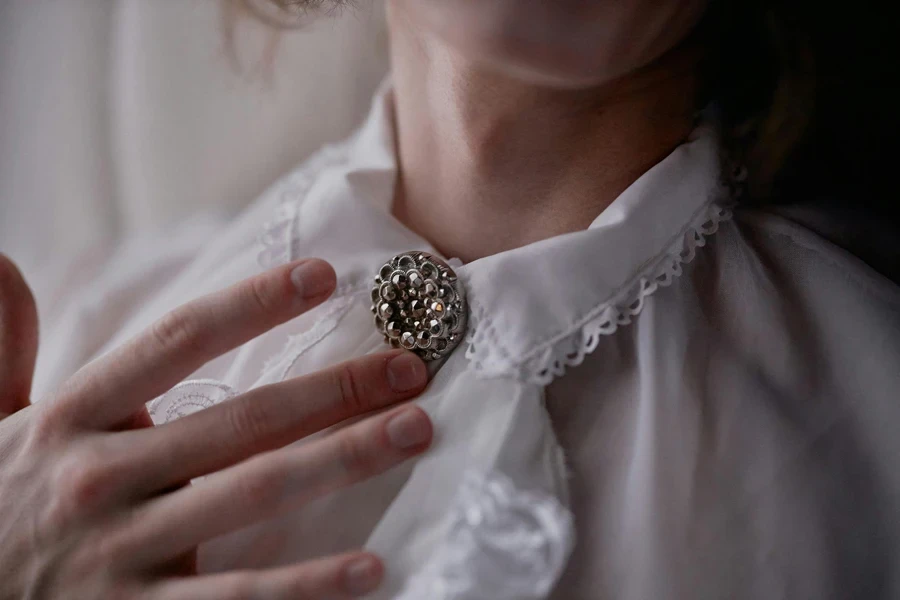
Brooches staged a conceptual renaissance with a 2.2 percentage point year-over-year increase, shedding traditionalist associations through radical formal interventions. Contemporary designers deploy surrealist scale manipulation and incongruous themes to transform pins into wearable dissent against algorithmic fashion homogenization. Miu Miu’s 8.5cm resin cockroach brooches—manufactured through 3D printing from recycled polymers and hand-finished with automotive-grade iridescent paint—epitomize this disruptive approach alongside Schiaparelli’s miniature bronze diving helmets featuring functional rivet detailing.
The movement’s cultural resonance manifests through digital behaviour patterns and commercial performance metrics. TikTok’s #ChaoticCustomization phenomenon, amassing 3.2 billion views, provides ideological scaffolding by championing intentional stylistic dissonance as self-expression. Market response proved immediate, with online vintage marketplace The Peacock Parlour reporting a 140% sales increase for 1980s brooches post-Paris Fashion Week. Pinterest’s 2025 trend forecast corroborates this momentum, identifying “punk pins” as a top search term with year-over-year growth exceeding 200%, signalling sustained consumer engagement.
Material Innovation and Ergonomic Maximalism

Designers resolved the maximalism-wearability paradox through advanced material engineering and ethical sourcing frameworks. Prada’s hollow titanium earrings weighing under 15 grams demonstrate how weight reduction technologies enable dramatic scale without compromising comfort during extended wear, effectively reconciling visual impact with physiological practicality. Concurrently, Gucci’s lab-grown spinel cuffs with deliberately fractured facets represent the industry’s maturation beyond superficial sustainability claims into materially embedded ethics that reject perfection tropes.
Market analytics confirm these innovations align with structural consumption shifts. Allied Market Research projects the sustainable jewellery sector will reach $60.7 billion by 2031, growing at 6.4% annually as consumers prioritize provenance transparency. Technical processes like Bottega Veneta’s lost-wax casting of recycled brass—producing collars simulating liquid gold’s viscosity—gain commercial validation through Lyst’s Q1 2025 report showing “recycled brass jewellery” searches rising 45% quarter-over-quarter. This synergy between material science and consumer values establishes new industry benchmarks.
Reinterpreted Nostalgia: The 1980s Reframed
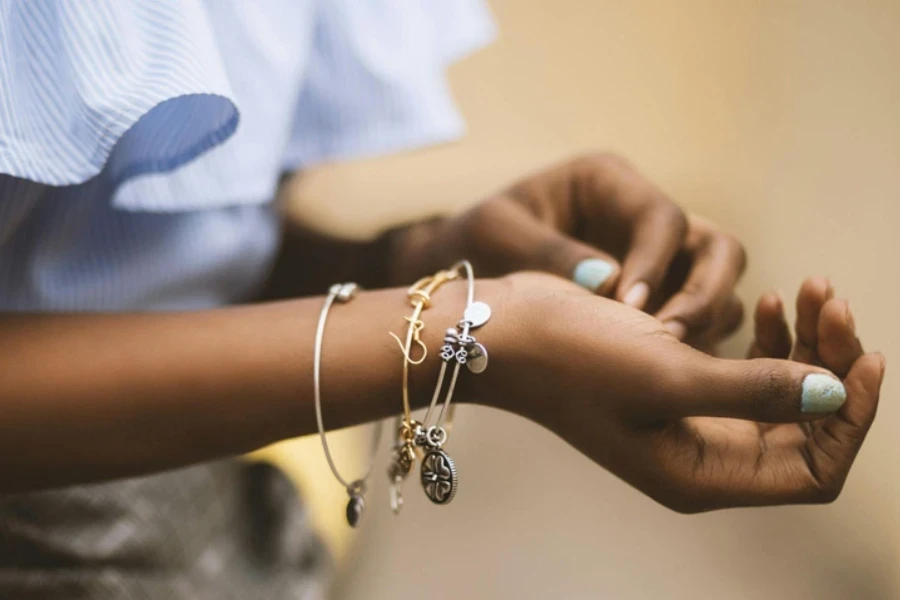
Decade nostalgia manifested through curated extraction of subcultural elements rather than mainstream revivalism. Saint Laurent’s 1.2-meter steel “anti-lariat” necklace with intentionally jagged, unclasped terminations embodies this selective engagement, translating punk’s disruptive ethos into luxury codes through calculated material dissonance. These historically literate designs reject superficial retro replication in favour of conceptually grounded reinvention that resonates with digital-native consumers seeking authenticity through disruption.
Quantitative behavioural data substantiates the trend’s commercial relevance. Google Trends measurements reveal “chunky bangles” queries increased 160% year-over-year across US/UK markets, while Rick Owens’ asymmetric 10cm oxidized-silver ear cuff presentation doubled search volumes for “asymmetric earrings” within two weeks. The directional styling choice—clamping only the right ear—exemplifies how contemporary nostalgia functions as critical commentary rather than decorative pastiche. This represents a maturation of retro-inspired design into culturally significant innovation.
Category Synergies and Modular Consumption
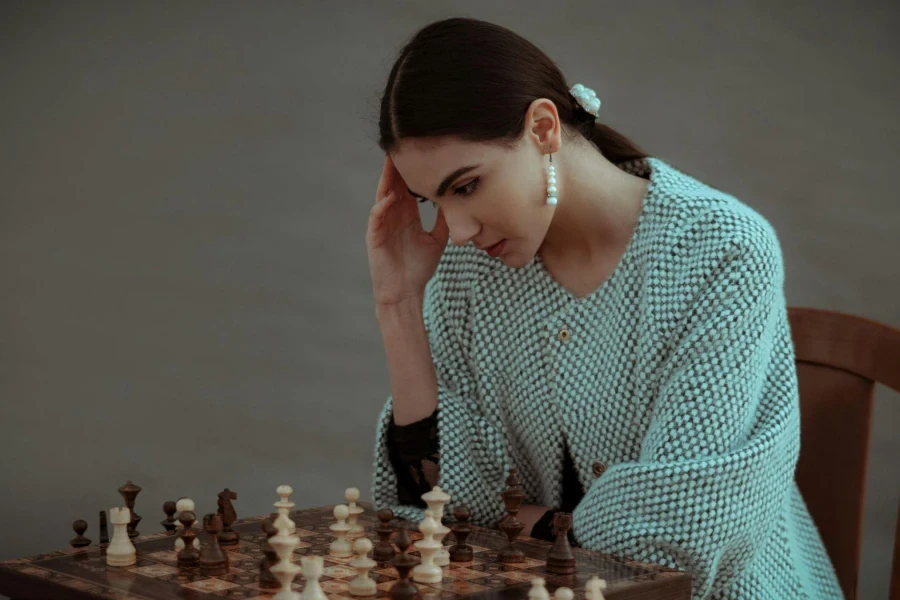
The coexistence of opposing aesthetics reveals sophisticated consumer behaviour patterns demanding strategic product architecture. While statement pieces dominated visual narratives, minimalist stud earrings grew 9 percentage points year-over-year, functioning as grounding elements within maximalist ensembles. This duality reflects consumers’ desire for versatile pieces that enable identity modulation across contexts, with Mejuri’s 4mm Mini Dome studs experiencing 73% post-fashion month sales growth as anchoring accessories.
Social media analysis confirms the systemic layering approach driving category synergies. Influential styling platforms like @AccessibleAlchemy demonstrate collar-and-stud pairings in 68% of autumn 2025 mood boards, creating balanced compositions that resolve maximalist-minimalist tensions. WGSN’s Consumer Values 2025 report quantifies this preference, noting 61% of Gen Z favours modular jewellery systems enabling contextual adaptability. These findings necessitate integrated collections rather than siloed category development.
Wristwear: Technical Innovation in Secondary Markets
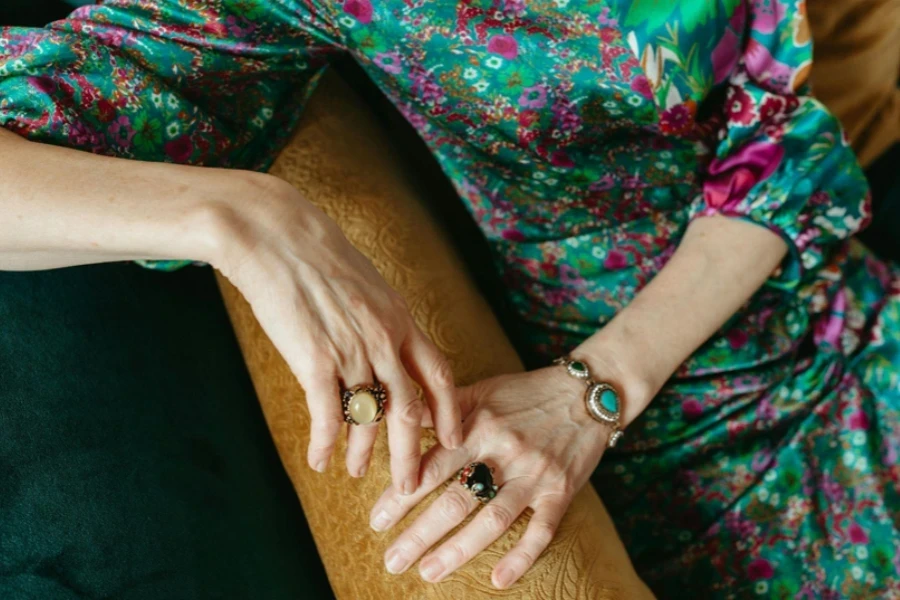
Wrist accessories demonstrated significant technical advancement despite lower profile than neckwear, signalling untapped market potential. Hermès’ patented magnetic closure system (EP 4103421A1) for saddle-leather cuff bands enables single-handed fastening—a direct response to Gen Z’s “functional luxury” demands that redefines ergonomic standards. This innovation transcends convenience to address accessibility needs within premium segments, expanding market inclusivity while maintaining design integrity.
Concurrently, material science breakthroughs expand expressive possibilities within wristwear. Bottega Veneta’s memory-metal cuffs retain structural integrity while mimicking crumpled foil’s organic irregularity, offering sculptural impact without rigidity. These developments align with emerging usage patterns documented by Pinterest’s 2025 data, which recorded a 112% year-over-year increase in saves for “stackable tech bracelets” among millennial users, indicating latent demand for wrist-focused innovation.
Strategic Implications and Forward Pathways
The Autumn/Winter 2025/26 jewellery landscape demands strategic recalibration toward neck-focused architectures and materially intelligent design philosophies. Investment priorities must include developing collar silhouettes utilizing textured metals or organic composites that combine visual impact with tactile engagement, alongside surrealist brooch designs targeting Gen Z’s appetite for disruptive customization. This requires cross-departmental collaboration between historical research teams and material scientists to ensure conceptually rigorous innovation.
Material engineering must advance weight reduction technologies through titanium hollow-forming and recycled brass processing, while sustainability initiatives integrate lab-grown stones with purposefully “flawed” finishes that reject industrial perfection. Brands that master jewellery’s transformation into cultural commentary—balancing conceptual boldness with ergonomic pragmatism—will capture disproportionate market share. The emergent paradigm treats adornment as identity infrastructure rather than decorative afterthought, demanding unprecedented design intentionality.
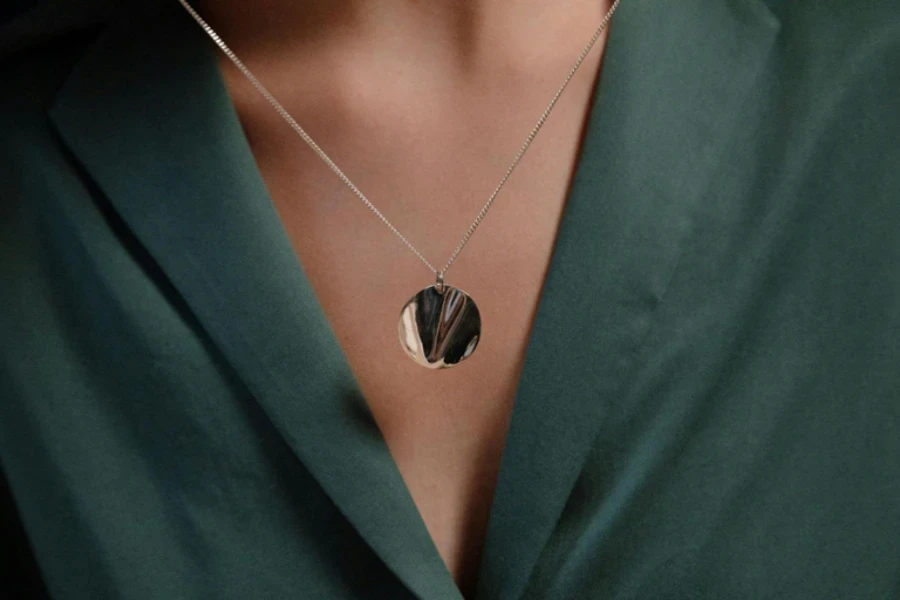
Conclusion: The New Adornment Paradigm
The Autumn/Winter 2025/26 season crystallises jewellery’s evolution from accessory to identity infrastructure. Three foundational shifts will define market success: Firstly, the neck’s prioritisation as the primary canvas for self-expression signals a permanent realignment beyond cyclical trend, demanding sustained R&D investment in collar architectures. Secondly, material intentionality has transitioned from ethical footnote to commercial imperative, where innovations like lab-grown spinels with fractured finishes represent aesthetic and value-driven advancements.
Most significantly, historical engagement now functions as cultural dialogue rather than decorative revival. Saint Laurent’s deconstructed lariat or Rick Owens’ asymmetric cuffs demonstrate how heritage becomes innovation fuel when filtered through contemporary sensibilities. Brands mastering this alchemy will lead the coming decade, transforming wearables into wearable philosophies that articulate our deepest tensions—between permanence and flux, weight and weightlessness, memory and possibility. The jewellery landscape has irrevocably shifted from ornament to articulation.
